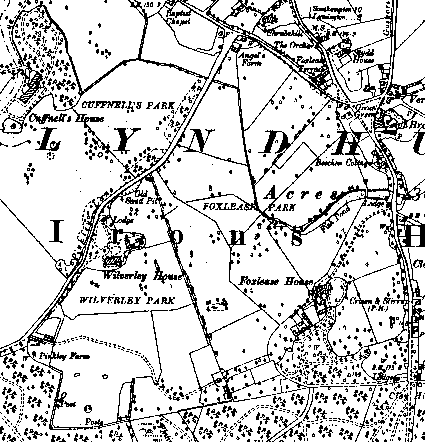Wilverley House and Park

Wilverley Park lies 1.5 kilometres (1 mile) to the south-west of Lyndhurst village centre. Bordered to the south by Brick Kiln Inclosure and the open woodland of Philip’s Hill, its western border adjoins Pinkney Lane, whilst immediately to the east is the Foxlease estate with which the history of Wilverley Park is inextricably linked.
Indeed, up to 1865, the lands that were to become Wilverley Park were part of the Foxlease estate, and had no separate existence.
The story really goes back, though, to Henry Weyland Powell, and his wife Eliza. The couple purchased the Foxlease estate in 1828 and at the same time acquired the land that was eventually to become Wilverley Park. Henry died in 1840, and following the death in 1865 of Eliza, Foxlease was sold by the eldest son, Henry Buckworth Powell. But Henry excluded from the sale a parcel of land on the edge of the estate, and so created for himself Wilverley Park.
Construction of Wilverley House was completed in 1867, and in 1869, at the age of 49, Henry married Lauretta Emiline Northey, daughter of General L. A. Northey, and the widow of Sir W. Dickson.
Henry in 1871 took the additional name Montgomery, but died seven years later – he is commemorated by an impressively ornate tablet in Lyndhurst parish church. His wife, Lady Dickson, continued at Wilverley until her death in 1890, an event reported in the October 18th edition of the Illustrated London News.
The estate passed to Henry Martin Powell, nephew of Henry Buckworth Powell Montgomery, and Master in the 1890s of the local foxhounds. In fact, members of the Powell family were still living at Wilverley at the on-set of the Second World War in 1939, during which the house was used as a home for evacuees.
Alan Oakenfull, who contributed to WW2 People’s War: An Archive of World War 2 memories, recalls:
‘…. when I was 9, we were moved to a home for children at Lyndhurst called Wilverley House. I suppose there were about 35 boys there - all from problem backgrounds because of the war. And we slept in dormitories with about 6 to a room. A Mr. Dimmock who I remember as being very fair ran the home. The setting in the Forest was lovely and across the farmland one could see another large house called Foxlease… We attended the Lyndhurst elementary church school. I remember going to church parades at the church opposite the school and also being prepared for confirmation by the vicar. Up the road from Wilverley was a bomb disposal unit, housed mostly in tents as I recall……
'I remember going to the small cinema in Lyndhurst — I think it was the Lyric — and seeing a film called ‘ Sailors Three’ starring Tommy Trinder. It involved a merchant ship carrying a cargo of bananas. As we had not seen a banana since the beginning of the war our tongues were hanging out at the sight of thousands of them... Near the home there was a farm and I recall the farmer plastering his hay crop with molasses in a large tank. We enjoyed eating the black treacle when we managed to get hold of a drum of it… While at Lyndhurst I became aware that something had happened at Dunkirk. This was because many of the French survivors were billeted nearby. This was probably my first sight of a foreigner…..’
After the War, the estate was sold to Barker Mills, and the house was eventually demolished. Maybe it had not been built to last much longer than its century, or so, of life; or perhaps the ravages of war-time usage took their toll. Quite possibly it was simply surplus to requirements, or considered too old fashioned or uncomfortable to be of use.
No pictures of the property have been located, but presumably it was a large Victorian house typical of the time, similar, maybe, to Stydd House on nearby Shrubbs Hill Road, or Annesley, further down Pinkney Lane, at Bank - both are of similar vintage.
Today, the park appears alone on modern maps, the old house remembered only by a cottage, and a lodge that to this day guards the estate entrance on Pinkney Lane.
Andrew Cameron provides more memories of Wilverley Park and Foxlease
References:
The History of Foxlease: Guide Association
Census records and local Directories, courtesy of the Christopher Tower New Forest Reference Library
Of what I remember of Lyndhurst and the neighbourhood nearly fifty years ago: Mrs. R. Bowden-Smith, courtesy of the Christopher Tower New Forest Reference Library
Thirty-five Years in the New Forest: Gerald Lascelles
More links
Other related links
Search this site

Sadly, 58 animals were killed - 35 ponies, 13 cows, 8 donkeys and 2 sheep, whilst a further 32 were injured - 3 pigs, 9 donkeys, 11 cows and 9 ponies.
(Forty-three accidents occurred in daylight, 15 at twilight and 101 in the dark. Twenty-seven accidents were not reported by the driver involved).
Here's just one horrific example - Three donkeys killed in collision with van at notorious New Forest blackspot (Advertiser and Times)

